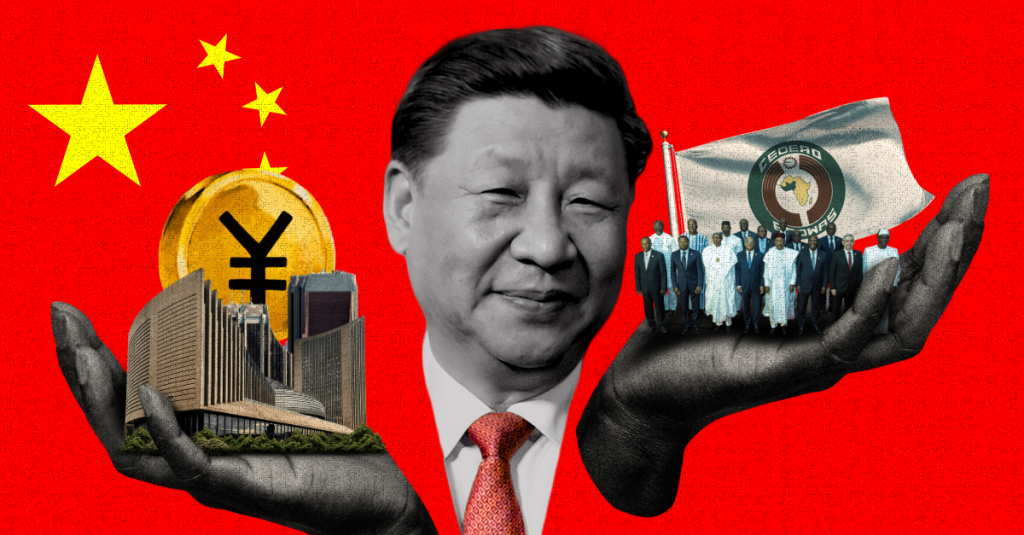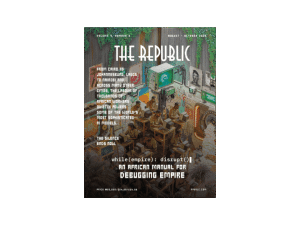
Photo illustration by Dami Mojid / THE REPUBLIC. Source Ref 1: Xi Jinping. ROMAN KUBANSKIY / WIKIMEDIA. Ref 2: ECOWAS 56th Ordinary Session, 2019. AFDB / FLICKR.
THE MINISTRY OF WORLD AFFAIRS
China’s Golden ‘Palace Diplomacy’ in West Africa

Photo illustration by Dami Mojid / THE REPUBLIC. Source Ref 1: Xi Jinping. ROMAN KUBANSKIY / WIKIMEDIA. Ref 2: ECOWAS 56th Ordinary Session, 2019. AFDB / FLICKR.
THE MINISTRY OF WORLD AFFAIRS
China’s Golden ‘Palace Diplomacy’ in West Africa
In 2018, the Economic Community of West African States (ECOWAS) signed a Memorandum of Understanding (MoU) with China to fund the building of a new headquarters for the West African bloc with a grant of $31.6 million. Initial talks to build the headquarters began in 2012 but the commitment was made official six years later with the MoU. The new permanent headquarters will be located along the Airport Road in Lugbe, Abuja, Nigeria’s capital city. It is expected to consolidate the ECOWAS Secretariat, the Community Court of Justice and the ECOWAS Parliament, which were originally located in separate buildings in Abuja; the Secretariat in Asokoro and the Court of Justice and Parliament in Central District. Though different, these two districts are within close range—about five kilometres or only 20 minutes apart by road.
According to the bloc, this separation had contributed to coordination issues among departments, impeding productivity and efficiency—hence the necessity to unite them into a single architecture. Official construction of the building began in November 2022 and has been dubbed the ‘Eye of West Africa’ after the late former Nigerian president, Muhammadu Buhari, first used the descriptor during a foundation-laying event for the headquarters with other African heads of state. Although initially reported by most media outlets as being expected to be completed in February 2025, an ECOWAS official noted in a remote interview with The Republic that it would be delayed until November 2025 due to the impacts of Israel’s genocide against Palestine, including disruptions to imported materials and longer shipping routes. Regardless, the project serves as a fitting gift to mark the bloc’s 50th anniversary earlier in May. The new permanent ECOWAS headquarters will be the first African regional economic community (REC) facility funded by Beijing, but the most recent in a string of foreign government facilities built and funded by China in Africa as far back as 1966.
A resounding question facing observers and analysts at this stage is—why ECOWAS? As discussions on the headquarters began in 2012, it may be difficult to situate China’s decision to fund this project based on current global political dynamics. Nevertheless, China is likely to be looking for a flashy, attractive infrastructural projects to strengthen its relations with one of Africa’s oldest regional blocs—perhaps for the purpose of accessing potential mineral benefits, expanding its market presence in the subregion, and exploring the geopolitical significance of the West African subregion, particularly with the Gulf of Guinea. Although the Southern African Development Community (SADC) and the East African Community (EAC) have their own strategic cooperation strategies with China, ECOWAS’s new headquarters is a deviation from the regular infrastructural projects of railways, seaports and bridges—which all constitute Beijing’s ambitious Belt and Road Initiative (BRI)—that have characterized China’s relations with African RECs.
ECOWAS–CHINA RELATIONS
Since the Forum for China–Africa Cooperation (FOCAC)—Beijing’s triennial summit with African leaders—and its ambitious action plans take centre stage in the discourse on Africa-China relations, Beijing’s relations with African RECs are largely underdiscussed. China’s desire to boost infrastructural development with these organizations has been duly followed by MoUs establishing trade routes and other forms of infrastructural projects. One such initiative is the Standard Gauge Railway project in Kenya, which is expected to support railway integration in East Africa. The timeline of partnership activities between Beijing and ECOWAS reveal initially strong relations. The first sign of intensive partnership was at the inaugural ECOWAS–China trade forum held in 2008 at China, where both parties discussed the development of hydropower, highways, water distribution, ship building, municipal construction, among other areas. The trade forum’s institutionalization motivated another meeting in 2012 with both parties in Accra, Ghana. While the practice has been discontinued for unknown reasons, its occurrence reflects ECOWAS’s formalized relations with China compared to other African RECs.
Despite this discontinuation, China and ECOWAS continue to have solid interactions and agreements. In January 2016, ECOWAS signed an MoU with the Chinese CGC Overseas Construction Group on five projects, including a trans-West Africa railway, the ambitious trans-West Africa coastal highway (which is also called the Dakar–Lagos coastal corridor), and the new ECOWAS headquarters. But a lot of things have changed since then. While the integrated railway never materialized, construction of the integrated coastal highway has kicked off with the first phase of the corridor to run from Abidjan to Lagos. However, its financial resources are being spearheaded by the African Development Bank and the ECOWAS Bank for Investment and Development—not China. It is also unknown why another MoU on the Chinese-funded headquarters had to be signed in 2018, despite an initial signing in 2016.
Aside from infrastructural projects, China has promoted the subregion’s security objectives, including by providing financial support and military equipment to the ECOWAS standby force for peacekeeping operations, as well as liaising with the bloc and its member states to coordinate Chinese troops in Mali.
While China still maintains strong bilateral relations with West African countries, its current relationship with ECOWAS is not on the same level. This is somewhat reflected in China’s BRI projects in the subregion, which tend to focus on national benefits rather than subregional benefits. However, the new headquarters can serve as a significant stepping stone in renewing the vigour of China-ECOWAS relations in recent years.
shop the republic
CHINA’S OBSESSION WITH AFRICAN GOVERNMENT FACILITIES
Since 1966, Beijing has refurbished and built government facilities in at least 40 African countries, ranging from parliamentary and foreign ministry buildings to ECOWAS’s headquarters, amounting to at least 186 in total. China’s decision to fund and build a new ECOWAS headquarters prompted experts to recall the Chinese-funded African Union (AU) headquarters in Addis Ababa, Ethiopia, in 2018 and reignited attention around Le Monde’s 2018 report that the headquarters were bugged by China to spy on African leaders. The report stated that a small cell of information technology experts at the AU observed an anomaly in the organization’s internal data system and servers between 2012 to 2017, causing them to reinstate new cybersecurity measures and change their furniture. Yet, China denied these allegations, and unsurprisingly, these were dismissed by the AU.
It may be difficult to trace the direct impact of China’s flashy gifts to African countries, but it is certain that such gifts have played a huge role in increasing Beijing’s engagement in the region. China is currently Africa’s largest trading partner, with total bilateral trade sitting at around $250 billion as of 2023, according to the SAIS China Africa Research Initiative (SAIS-CARI). China’s infrastructure development in Africa can be perceived in two categories. The first would be regular infrastructural projects such as railways, seaports and other trade routes that establish supply chains for mutual economic interests. The second categorization does the real work promoting its soft power and political messaging in Africa—which is the practice of funding, building and gifting posh government buildings, which Joshua Meservey, a senior fellow at Hudson Institute, has termed ‘palace diplomacy’—a title only fitting for the skyline glamorous buildings that contradict the poverty crises in most of these countries.
China’s commitment to its palace diplomacy in Africa is very commendable and has become a key diplomatic strategy for Beijing. Through its larger infrastructure agenda, Beijing has been able to address the region’s infrastructural poverty, prompting an African senior official’s remark that, ‘when the Chinese visit, we get a train station. When the Americans visit, we get a speech.’
However, the danger in China’s approach lies in the fact that these buildings are gifted through grants or interest-free loans. As there is no such thing as a ‘free lunch’, many Western scholars have been quick to connect many of Africa’s ‘political favours’ to China at global political architectures like the United Nations to Beijing’s palace diplomacy. Likewise, Beijing has ensured to blend local architectural designs with modern government buildings, reflecting their reverence for African traditions which aligns well with their rhetoric of ‘South-South cooperation’.
China was likely forced to pursue its palace diplomacy due to the competitive advantage of the African region. While discussions around China’s growing interest in Africa began in the twentieth century, it is a well-established fact that relations between Africa and Beijing began as far back as the colonial era. China’s need to counter Western influence in Africa called for an aggressive strategy. It is evident now that China’s aggressive effort through its infrastructure agenda was just the right amount to push away its other competitors and consolidate its influence in the continent for the long run.
shop the republic
A SPECIAL FOCUS ON WEST AFRICA?
The headquarter completion coincides with another suggestion that the subregion could get more attention from China in the next three years. Experts espouse that China has shown interest in expanding activities in western Africa, which has been aided in particular by Chinese investment channelled through the BRI. The West African subregion dominates Beijing’s port projects, totalling 35 in number—the highest number of Chinese port projects in Africa and any other subregion in the global community, attracting $6.533 billion of Chinese investment funds. These ports are a key product of China’s Go Out strategy, serving as connector routes that aid supply chains for the BRI. Beijing’s port development in western Africa provides funding for efficient infrastructure and provides an opportunity for these nations to increase their exports to China, which will be further enabled by Beijing’s recent zero-tariff policy on African countries. In line with discussions at the 2024 FOCAC summit, the ports could enable the transfer of technology and agricultural training programmes, which will be huge benefits to the agriculture-oriented West African economies, reducing food insecurity and agricultural unproductivity. Nevertheless, the initiative itself is indeed highly strategic for China. The southeast Asian country is harnessing West Africa’s 7,000 kilometres coastline to access the subregion’s natural resources, connecting it to the larger global supply chain—a strategy that has been overlooked by other external powers.
China is also hoping to use its West African seaports for military purposes. Some of these ports host joint military training and drills for China and West African nations. This could be an effort to protect its emerging port systems in the subregion, especially in the Gulf of Guinea, which is notoriously known for sea piracy and maritime insecurity. China’s interest in the Gulf is growing steadily due to its interests in oil exploration, but it has been impacted by maritime criminal activities. It will therefore be unsurprising to see Beijing spearheading counter-piracy operations, as, according to Paul Nantulya, a research associate at the Africa Centre for Strategic Studies, increased economic activities will attract sea pirates.
China’s preexisting activities in the West African region pair perfectly with its 2024 FOCAC strategy of increasing its focus on security and military cooperation for Africa through its Global Security Initiative. This includes the provision of counterterrorism resources and training for African security institutions and militaries to aid the fight against violent extremism. While many presume that this security interest is an avenue to protect its economic interests and secure Chinese nationals, Eric Olander, Co-Founder of The China Global South Project, emphasized during a remote interview with The Republic that ‘we cannot use the example or the model of what the United States (US) or the Europeans have done in Africa and apply that to the Chinese. The Chinese have a very, very different approach.’
China’s increasing relations with ECOWAS could be to the detriment of its failing relations with the junta-oriented Alliance of Sahel States (Alliance des États du Sahel—AES), consisting of Mali, Niger and Burkina Faso. While the ‘three horsemen of the central Sahel’ would have served as a good ground for testing China’s counterterrorism initiatives against the notorious Jama’at Nasr al-Islam wal-Muslimin, Beijing’s ties with the subregional bloc are likely to discourage AES’s engagement with China. Recently, the ‘junta strategy of resource nationalism’ and the desire for these states to monitor their economic sovereignty could continue to limit China’s economic interest in West Africa, as seen in Niger.
shop the republic
-
‘The Empire Hacks Back’ by Olalekan Jeyifous by Olalekan Jeyifous
₦70,000.00 – ₦75,000.00Price range: ₦70,000.00 through ₦75,000.00 This product has multiple variants. The options may be chosen on the product page -
‘Make the World Burn Again’ by Edel Rodriguez by Edel Rodriguez
₦70,000.00 – ₦75,000.00Price range: ₦70,000.00 through ₦75,000.00 This product has multiple variants. The options may be chosen on the product page -
‘Nigerian Theatre’ Print by Shalom Ojo
₦150,000.00 -
‘Natural Synthesis’ Print by Diana Ejaita
₦70,000.00 – ₦75,000.00Price range: ₦70,000.00 through ₦75,000.00 This product has multiple variants. The options may be chosen on the product page
shop the republic
THE FUTURE ARCHITECTURE OF ECOWAS-CHINA RELATIONS
As China and Russia’s influences continue to increase in Africa, and the middle powers like Turkey are slowly rising on the engagement pedestal with the region, African leaders are constantly reminded to uphold transparency and sovereignty in their dealings with these nations. Their dismissal of the spying allegations against Beijing for the AU headquarters and increased investment of China in the subregion subtly foreshadows the leaders’ reaction to any future speculations of espionage with the new ECOWAS headquarters. While the leaders of the Sahel-junta nations may not be the best model nations when it comes to governance, they do provide admirable examples of pathways to economic sovereignty and natural resource governance. Their playbook will be essential when China exercises its infrastructural agenda in West Africa through the expansion of the BRI and more flashy government buildings.
That said, this could be a good opportunity to rejuvenate the China ECOWAS Trade Forum as a periodic event where ECOWAS leaders dialogue and work out transparency and sovereignty concerns with Chinese companies and projects. Olander argues that in addition to the lack of transparency on Beijing’s part, African governments also fail to publish loan agreements, which are a requirement of many national laws. Practising this will help West African countries enforce their own laws and hold China accountable.
Furthermore, contrary to African leaders at FOCAC, it is important that West African nations hold a united front if they renew their trade platform with China. ECOWAS’s 50-year trajectory does not make this unity easy, as according to Olander, strong disagreements between the likes of Nigeria and Ghana as to what their priorities are often trump advocacy attempts for a united front. Resolving these differences and agreeing to a single priority will aid the attainment of their goals.
Similarly, the feasibility of a united west African front against China’s infrastructural diplomacy in the subregion may be threatened by evolving dynamics between ECOWAS and the AES bloc. In a policy brief, Hermain Sam, a programme coordinator at the German Marshal Fund for the US, argues that how both blocs chose to engage with one another will affect the region’s relations with external powers, forcing players like Beijing to rethink its regional role. While diplomatic tensions between Sahelian states across opposing blocs, such as Ivory Coast and Burkina Faso, could threaten the formation of a united front, both blocs are likely to engage in parallel cooperation on mutual issues, particularly in light of their shared strategic and economic engagements with China⎈
BUY THE MAGAZINE AND/OR THE COVER
-
‘Make the World Burn Again’ by Edel Rodriguez by Edel Rodriguez
₦70,000.00 – ₦75,000.00Price range: ₦70,000.00 through ₦75,000.00 This product has multiple variants. The options may be chosen on the product page -
The Republic V9, N2 Who Dey Fear Donald Trump? / Africa In The Era Of Multipolarity
₦40,000.00
















